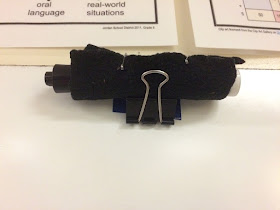...
...
I hate paper. I know, I know...how could @TypeAMathLand, one of the queens of the INB hate paper? I know...but really, I can't stand the paper management of teaching. Things to file, papers to grade, master copies to organize (or as you may have seen on Twitter, leave alone for a semester and take a whole day to organize).
Another confession: I'm horrible about passing out papers. I'll even write it down but still forget once I get caught up in actually teaching the humans entrusted to my care.
So pretty much anything that limits the flow of paper in my classroom makes me happy.
At my previous school, I almost never collected classwork and didn't grade at all homework. I could create my own grading system. But it's my first year at a new school so not trying to rock the boat in every arena and choose my battles. Overall the department is about 80% assessments and 20% classwork/homework/notebooks. This had been driving my SBG self a little crazy, oh well. But since I need to do it, I had to find a more efficient, time-effective way to handle this. I just did the typical collect, grade, and return (or not) and even though I was doing this - students couldn't see the effect of doing work (gasp) and their grade.
So enters: the stamp sheet. I feel so middle school/elementary school for this. But, work completion is improving. I'm getting a lot more work turned in period (both on time and late), and thus test scores are improving since we are actually starting to see a relationship between doing the work and not doing the work.
That's a lot of words so here's the nitty gritty of how it works.
1) Each period is a different color (mine is 1st: green, 2A: Red, 3A: Yellow, 2B: Blue, 4B: Purple). All the folders for the class are the same physical color.
2) My groups are color coded as well. The folder is labeled with the color group.
3) Students turn in work to the left pocket. This is also where I put no name papers (no more wondering who those go to) and assignments that I don't consider satisfactory that they need to redo/finish
4) Stamp sheets for the group go in the prongs
5) Once I've stamped their sheets for the assignments, I put the assignments in the back and they can take them out and do whatever with them.
I can then see at a glance certain students are consistently not turning something in and try to have a conversation with them and parents about that. I also put an A for absent if they weren't there that day.
I cross off any time I didn't collect something for that box.
Red Folder so I know this is my 2A class. Purple Group.
What it should look like:
Oops, we have some missing work.
There ya go! Hope that helps someone. Also, I'm only going to enter the scores every week or every other week. I can't find my excel spreadsheet where I made the actual sheet, but will link it when/if I do =).
Edit to answer some questions from Twitter:
1) I change groups every 5 class periods
2) Students turn in assignments at same time, so already pretty aware of who is/isn't turning in assignments. Things are only checked for a valid attempt, so no "scores" being shown. And assignments can be turned in late, so it is really just communicating what is missing.
3) Every student gets their own stamp sheet (I laid out the whole quarter on it) that is kept in their folder. There are 4-6 sheets per group because I different sized groups.
4) I only stamp the stamp sheet, not the paper. If they care they can just look at the stamp sheet ;-). But once again, I'm just looking for valid attempts and any ? marks they put on their work which I respond to on their paper.























